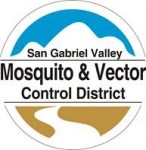 August 23, 2011 – West Nile Virus Continues to Circulate in Valley – Public Vigilance Has Helped
August 23, 2011 – West Nile Virus Continues to Circulate in Valley – Public Vigilance Has Helped
The SGV Mosquito and Vector Control District’s West Nile virus (WNV) surveillance team continues to find evidence of WNV transmission in the San Gabriel Valley.
To date:
- Seventeen (17) birds have tested positive for WNV this year from the following cities: Arcadia, Azusa, Baldwin Park, Claremont, Covina, La Puente, and West Covina.
- Five (5) mosquito samples collected from Covina, Irwindale, La Puente, and West Covina have tested positive indicating increased risk in these communities.
- One (1) chicken from a sentinel flock in the City if Irwindale
- The County’s first equine case was reported from the San Gabriel Valley on August 11th by Los Angeles County Veterinary Public Health Department.
Dead birds reported by the public to the WNV Hotline (877.WNV.BIRD) have helped vector control districts zero in on WNV “hot spots” to suppress virus activity. Mosquitos that feed on sick birds can spread the virus further. Reducing mosquito populations in these hot spots is essential to break the transmission cycle. “We can’t thank the public enough for their assistance this year” notes Steve West, the District’s General Manager, “Even if we can’t pick up the birds, knowing where they are dying helps tremendously.”
As we enter the peak transmission season, three (3) of the State’s twelve confirmed human cases are from Los Angeles County. The number of cases is still low, but experts expect that number to rise. “Virus levels in Los Angeles County mosquitoes and wild birds indicate a high risk this year” cautions Kenn Fujioka, the District’s Assistant Manager.
The County’s first epidemic in 2004 resulted in 331 cases and 14 deaths. In 2008, a resurgence of the virus caused 156 cases and 6 deaths. West Nile virus causes illness and death every year. Unfortunately, many likely cases are never tested and confirmed by physicians.
If bitten by an infected mosquito, illness can range from the milder West Nile Fever (WNF) to the more severe West Nile Neurologic Disease (WNND). Symptoms of WNF include headaches, muscle aches, rash, and extreme fatigue requiring weeks to months to recover. WNND results when the virus attacks the brain and/or central nervous system resulting in serious, life threatening complications. People over 50 and those with underlying medical conditions are at higher risk for the more severe disease.
Fujioka warns, “There are a lot of infective mosquitoes out there. If people do not take the necessary precautions this summer, their risks are definitely higher.”
Protective measures include:
□ DRAIN: Check properties weekly and remove all sources of standing water. Report ‘green’ inoperable pools or other sources of standing water to the District
□ DUSK TO DAWN: Wear effective repellents if outdoors when mosquitoes are present (between dusk and dawn)
□ DEFEND: Ensure doors and windows are properly screened to keep mosquitoes out of the home.
□ Horse owners should ensure their horses are current on their vaccinations.
The District encourages the public to help identify WNV “hot spots” by reporting dead birds to the WNV Hotline at (877) WNV-BIRD (877-968-2473) or online at www.westnile.ca.gov. We also urge our residents to call the District to report any mosquito activity.
The San Gabriel Valley Mosquito & Vector Control District is a public health agency dedicated to the control of mosquito and other vector-borne diseases. The District can be reached at 626-814-9466 or on the web at www.sgvmosquito.org
